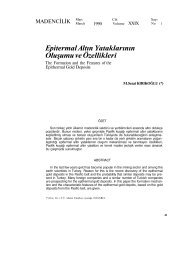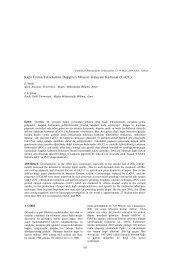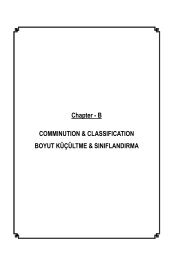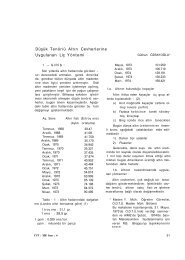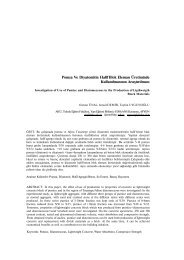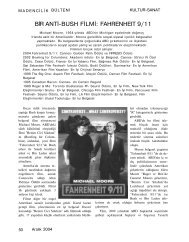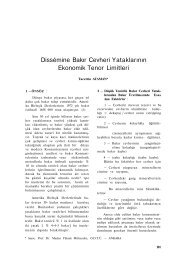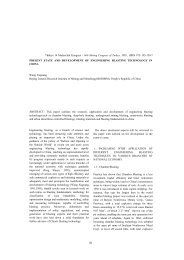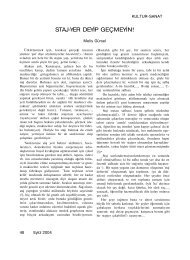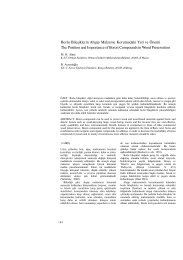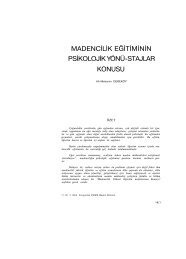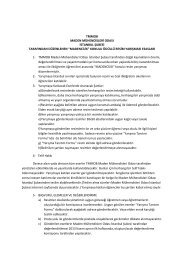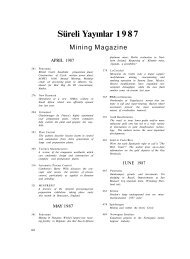A OPEN PIT MINING AÇIK OCAK MADENCİLİĞİ
A OPEN PIT MINING AÇIK OCAK MADENCİLİĞİ
A OPEN PIT MINING AÇIK OCAK MADENCİLİĞİ
You also want an ePaper? Increase the reach of your titles
YUMPU automatically turns print PDFs into web optimized ePapers that Google loves.
.<br />
23 rd <br />
Figure 6. Ultimate pit limit based on gradetonnage<br />
curve (not blend pit) and optimized<br />
pit-blend<br />
6 DISCUSSIONS AND CONCLUSIONS<br />
Pit limit is a set of those blocks that are<br />
profitable to be exploited by open pit mining<br />
methods. There are a number of pit design<br />
algorithms which require that the economic<br />
value of each block to be determined prior to<br />
applying the algorithms. In traditional pit<br />
limit optimization techniques, one cannot<br />
take into account the requirements of<br />
blending. Some commodities such as iron<br />
ore, coal, limestone, and industrial minerals<br />
that are direct shipped need to be blended to<br />
provide a product that suits consumer’s<br />
requirements. In order to determine the<br />
economic value of these blocks, one needs to<br />
first select the set of blocks that can be<br />
blended. After this, one could apply any<br />
available method to determine the ultimate<br />
pit limit (UPL). In this paper a combined<br />
approach is used to determine the pit limit of<br />
an open pit mine considering the<br />
requirements of blending. In this approach,<br />
using a self-adaptive differential evolution<br />
algorithm, called jDE, first those ore blocks<br />
that meet the blended product requirements<br />
are selected, and then the ultimate pit limit is<br />
determined using maximum flow theory. The<br />
resulting pit is a combination of those blocks<br />
that are profitable to be exploited by open pit<br />
mining and are capable of being shipped<br />
directly. This method is helpful in<br />
conducting a better production plan with<br />
regard to satisfy the consumer’s<br />
requirements.<br />
The proposed blending model is an integer<br />
programming model and it is solved using<br />
jDE algorithm. The jDE is a fast algorithm<br />
for solving large optimization problems. In<br />
determining the pit-blend limit for the mine,<br />
the time of extracting the block is not<br />
considered. It is an obligation for the mine to<br />
produce a final product with a stable quality.<br />
So, using the pit-blend optimizer for long<br />
term planning may not be useful, but,<br />
determination of an optimized pit-blend limit<br />
is very helpful in medium term and short<br />
term mine planning.<br />
REFERENCES<br />
Akbari, A. D., Osanloo, M., &Akbarpour, S. M.,<br />
2009. Reserve estimation of an open pit mine<br />
under price uncertainty by real option approach,<br />
Mining Science and Technology, China<br />
University of Mining and Technology, 19(6),<br />
pp.709-717.<br />
Back, T., Fogel, D. B., &Michalewicz, Z., (Eds.),<br />
1997. Handbook of Evolutionary<br />
Computation.New York, Inst. Phys. and Oxford<br />
Univ. Press, 1130 pages.<br />
Brest, J., Greiner, S., Mernik, M., &Zumer, V.,<br />
2006. Self-adapting control parameters in<br />
differential evolution: A comparative study on<br />
numerical benchmark problems, IEEE<br />
transactions on evolutionary computation, Vol.<br />
10, No. 6, pp. 646-657.<br />
Bongarcon, D.F., &Marechal, A., 1976. A new<br />
method for open pit design: Parameterization of<br />
the final pit contour, In Proceedings 14th Int.<br />
APCOM, pp.573-583.<br />
Dagdelen, K., 2007. Open Pit optimization -<br />
strategies for improving economics of mining<br />
projects through mine planning, in Proc. of<br />
Orebody modeling and stochastic mine planning,<br />
Spectrum Series Vol. 14, pp.145-148.<br />
Deb, K., 2005. A population-based algorithmgenerator<br />
for real-parameter optimization, Soft<br />
Computing- AFusion of Foundations,<br />
Methodologies and Applications, Vol. 9, No. 4,<br />
pp.236–253.<br />
Denby, B., & Schofield, D., 1994. Open pit design<br />
and scheduling by use of genetic algorithm,<br />
Transactions of the Ins. of Mining and<br />
Metallurgy, vol. 103, pp.A21- A26.<br />
Giannini, L. M., Caccetta, L., Kelsey, P., &Carras,<br />
S., 1991. <strong>PIT</strong>OPTIM: A new high speed network<br />
flow technique for optimum pit design facilitating<br />
rapid sensitivity analysis, AusIMM Proc., No. 2,<br />
pp.57-62.<br />
Hochbaum, D. S.,& Chen, A., 2000. Performance<br />
analysis and best implementation of old and new<br />
algorithms for the open pit mining problem,<br />
Operation Research, 48(6), pp.894-914.<br />
127



